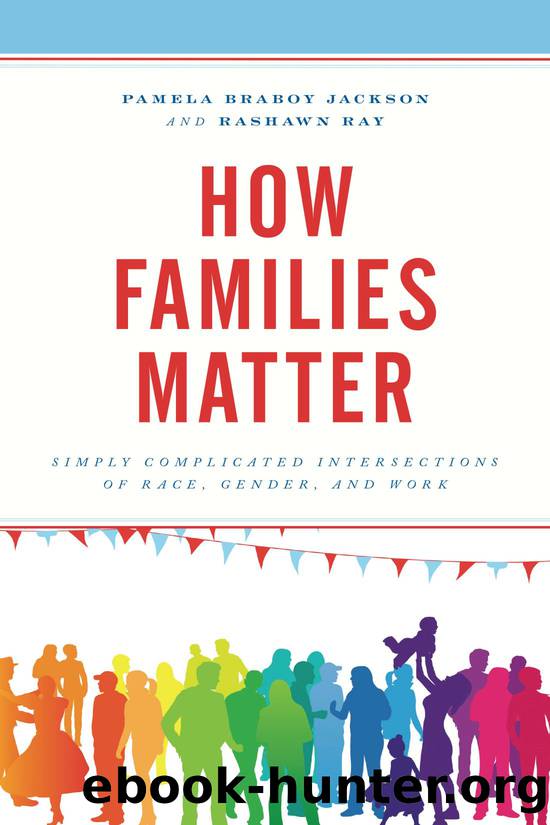How Families Matter by Jackson Pamela Braboy;Ray Rashawn;

Author:Jackson, Pamela Braboy;Ray, Rashawn;
Language: eng
Format: epub
Publisher: Lexington Books/Fortress Academic
Chapter 4
What Is Family Togetherness?
Family relationships provide the opportunity to build trust through togetherness. But what is togetherness? Why do we want to be together? How do we try to be together? Are we successful in our efforts to get together? This chapter will address togetherness in the form of family rituals; the meaning of which might vary across diverse populations. In the next section, we demonstrate synergy in conversations about togetherness and the individualism (family decline)âcollectivism (family resilience) debate. People draw on their close social relationships in times of stress and in times of celebration. As such, a sense of togetherness operates within a family system to either reestablish equilibrium or strengthen the FoO identity. In either case, families require the economic resources afforded through paid work to facilitate efforts to get together.
Background
According to long-standing philosophic thought, people have an intrinsic desire to feel part of something greater than themselves. This disquieting seems somewhat resolved in moments of togetherness. For some, a sense of togetherness is formulated in early life as intimacy and expressed as âsymbolicâ attachment across the individual life course.1 Subsequently, we develop a sense of perceived closeness to those in our social networks and are more likely to form strong relationships with these significant others. Another academic camp views togetherness as broader patterns of social solidarity. Building primarily upon Emile Durkheimâs work, social solidarity has become an all-inclusive concept represented as social capital (e.g., norms of trust and reciprocity), social cohesion (e.g., equality in civic engagement and the distribution of other valued societal resources), and/or social integration (e.g., embeddedness and/or participation in social roles)âall of which are collective dimensions of society.
Although viewed as an important element to the general welfare of any society, there is just as much debate about the operationalization of social solidarity as there is the âhypothesizedâ decline in social solidarity within the United States.2 Nonetheless, high levels of participation in socially-approved group activities made equally available to a citizenry is an indication of âtogethernessâ or indications that a society is high in social solidarity. An individual would thus feel connected to a larger group beyond their family unit and would develop, for example, a national (or at least a âcivic-lyâ oriented group) identity.
A potential mechanism linking the desire to connect with others to actual behavior patterns is family identity. Consistent with the theoretical ideas underlying Strykerâs (1980) personal identity theory, we find that the FoO identity is cultivated over the life course. Adults are subsequently more likely to pursue opportunities to enact those identities. Some activities are replicated over time in the context of family gatherings, including time-honored traditions. Mead (1978), and others, refers to such patterned interactions as rituals. Despite concerns about âprogressing individualism,â3 we find evidence in this study that Americans still rely on discrete family traditions to generate a sense of togetherness (or collective identity and interdependence). Thus, we frame our analysis using family ritual theory (FRT).
When asked to âtell me a story about your family,â some of our
Download
This site does not store any files on its server. We only index and link to content provided by other sites. Please contact the content providers to delete copyright contents if any and email us, we'll remove relevant links or contents immediately.
Should I Stay or Should I Go? by Ramani Durvasula(6850)
The Lost Art of Listening by Michael P. Nichols(6530)
The Rosie Project by Graeme Simsion(5237)
We Need to Talk by Celeste Headlee(4920)
Beartown by Fredrik Backman(4489)
Suicide Notes by Michael Thomas Ford(4300)
Hunger by Roxane Gay(4259)
Ego Is the Enemy by Ryan Holiday(4049)
I Love You But I Don't Trust You by Mira Kirshenbaum(3269)
Mummy Knew by Lisa James(3189)
Crazy Is My Superpower by A.J. Mendez Brooks(2890)
Girl, Wash Your Face by Rachel Hollis(2849)
The Complete Idiot's Guide to Coping With Difficult People by Arlene Uhl(2848)
Toxic Parents by Susan Forward(2835)
Not a Diet Book by James Smith(2770)
The Hard Questions by Susan Piver(2573)
Name Book, The: Over 10,000 Names--Their Meanings, Origins, and Spiritual Significance by Astoria Dorothy(2516)
The Gaslight Effect by Dr. Robin Stern(2373)
The Social Psychology of Inequality by Unknown(2346)
